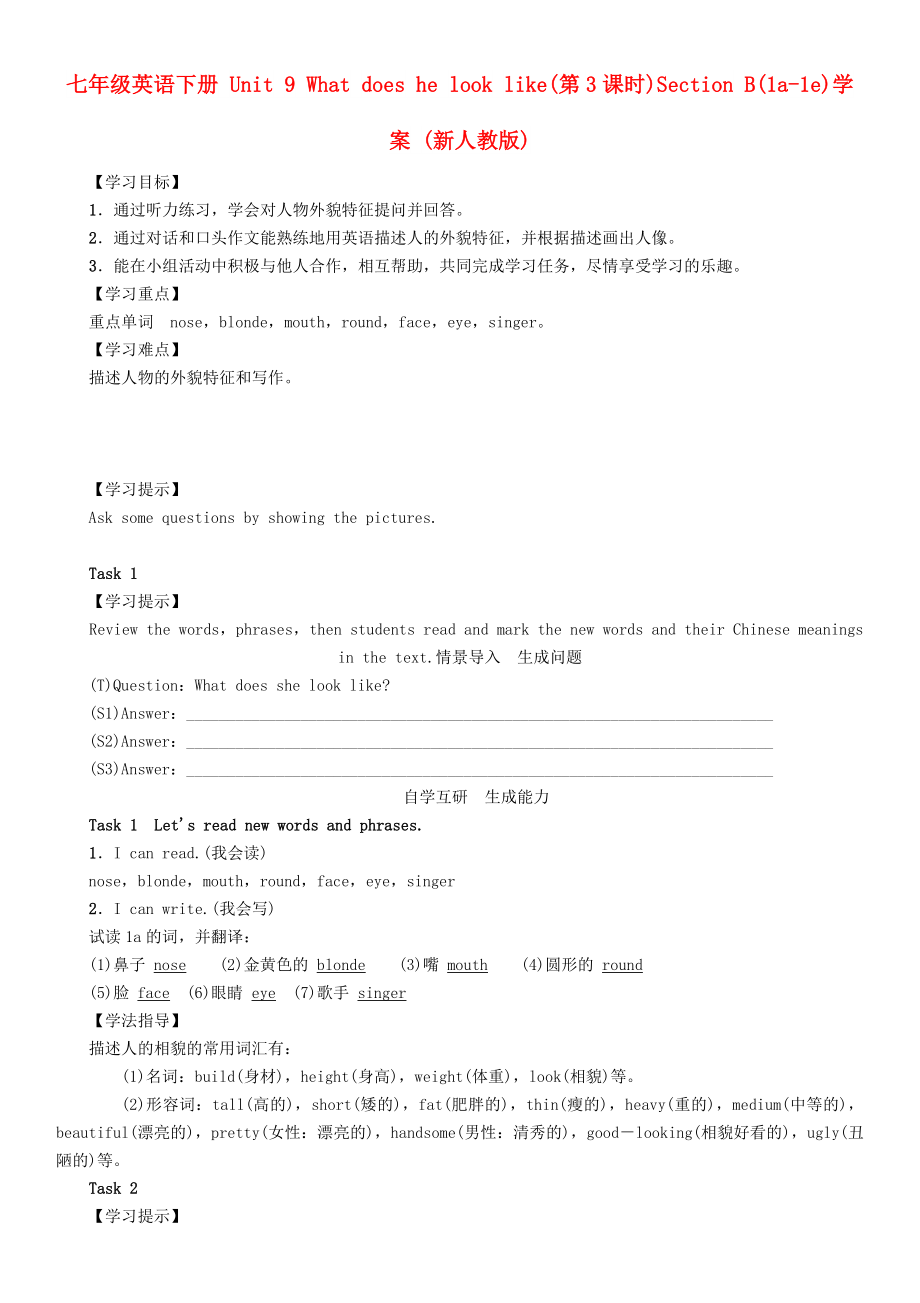《七年級(jí)英語(yǔ)下冊(cè) Unit 9 What does he look like(第3課時(shí))Section B(1a-1e)學(xué)案 (新人教版)》由會(huì)員分享,可在線閱讀�,更多相關(guān)《七年級(jí)英語(yǔ)下冊(cè) Unit 9 What does he look like(第3課時(shí))Section B(1a-1e)學(xué)案 (新人教版)(3頁(yè)珍藏版)》請(qǐng)?jiān)谘b配圖網(wǎng)上搜索。
1�、七年級(jí)英語(yǔ)下冊(cè) Unit 9 What does he look like(第3課時(shí))Section B(1a-1e)學(xué)案 (新人教版)
【學(xué)習(xí)目標(biāo)】
1.通過聽力練習(xí),學(xué)會(huì)對(duì)人物外貌特征提問并回答��。
2.通過對(duì)話和口頭作文能熟練地用英語(yǔ)描述人的外貌特征�,并根據(jù)描述畫出人像���。
3.能在小組活動(dòng)中積極與他人合作����,相互幫助���,共同完成學(xué)習(xí)任務(wù)����,盡情享受學(xué)習(xí)的樂趣���。
【學(xué)習(xí)重點(diǎn)】
重點(diǎn)單詞 nose��,blonde��,mouth�,round,face���,eye�,singer���。
【學(xué)習(xí)難點(diǎn)】
描述人物的外貌特征和寫作�。
【學(xué)習(xí)提示】
Ask some questions by
2�����、 showing the pictures.
Task 1
【學(xué)習(xí)提示】
Review the words�����,phrases���,then students read and mark the new words and their Chinese meanings in the text.情景導(dǎo)入 生成問題
(T)Question:What does she look like?
(S1)Answer:________________________________________________________________________
(S2)Answer:_______
3�、_________________________________________________________________
(S3)Answer:________________________________________________________________________
自學(xué)互研 生成能力
Task 1 Let's read new words and phrases.
1.I can read.(我會(huì)讀)
nose����,blonde,mouth,round���,face�����,eye�,singer
2.I can write.(我會(huì)寫)
試讀1a的詞�����,并翻譯:
4��、(1)鼻子 nose (2)金黃色的 blonde (3)嘴 mouth (4)圓形的 round
(5)臉 face (6)眼睛 eye (7)歌手 singer
【學(xué)法指導(dǎo)】
描述人的相貌的常用詞匯有:
(1)名詞:build(身材)�����,height(身高)���,weight(體重),look(相貌)等�����。
(2)形容詞:tall(高的),short(矮的)��,fat(肥胖的)��,thin(瘦的)�����,heavy(重的)����,medium(中等的),beautiful(漂亮的)���,pretty(女性:漂亮的)��,handsome(男性:清秀的)���,good-looking(相貌好
5、看的)����,ugly(丑陋的)等。
Task 2
【學(xué)習(xí)提示】
1.Turn to P52.Ask students to listen to 1c and finish it.Then listen again and repeat.
2.Ask students to listen and finish 1d.
【學(xué)法指導(dǎo)】
【辨析】wear���,put on與have on
(1) wear是“穿著���;戴著”的意思����,強(qiáng)調(diào)狀態(tài)�����。
(2) put on意為“穿上�;戴上”,強(qiáng)調(diào)動(dòng)作��,是終止性動(dòng)詞短語(yǔ)���,不能與表示一段時(shí)間的狀語(yǔ)連用。
(3)have on意為“穿著���;戴著”���,與wear同義
6、�,指穿的狀態(tài)�����,其后可以接表示衣服�、帽子�����、鞋子的名詞�。
Task 3
【學(xué)習(xí)提示】
Finish 1e.Then make conversations.
【學(xué)法指導(dǎo)】
1.形容詞的用法
形容詞常用來(lái)修飾名詞,表示名詞的屬性��,補(bǔ)充說(shuō)明名詞的意思�。在句中作定語(yǔ)、表語(yǔ)��、賓語(yǔ)補(bǔ)足語(yǔ)等�����。
如:It is very cold today.今天天氣很冷���。
She is a nice girl.她是一個(gè)好女孩����。
Keep the door open.讓門開著。
2.形容詞的位置
(1)形容詞一般放在名詞前作定語(yǔ)��。
如:I f
7����、ind he is a clever boy.我發(fā)現(xiàn)他是一個(gè)聰明的孩子。
(2)形容詞修飾something���,anything��,nothing等不定代詞時(shí)�����,要放在這些詞的后面����。
【備注】
8��、
3.I can summarize.(我會(huì)總結(jié))
描述人體器官的詞有哪些����?
【觀察】(1) His face is a little small����,but his mouth is big.
(2)The Russian has a big nose.
【發(fā)現(xiàn)】英語(yǔ)中與人體五官有關(guān)的名詞有:head(頭)����,hair(頭發(fā))���,face(臉)��,eye(眼)���,ear(耳朵),nose(鼻子)���,mouth(嘴)����,neck(脖子)��,tooth(牙齒)
9�����、��,throat(喉嚨)等。
與人體四肢有關(guān)的名詞有:hand(手)�,foot(腳),arm(手臂)���,leg(腿)�。
其他與人體有關(guān)的常見名詞有:back(背部)���,stomach(胃)等�����。
見所贈(zèng)光盤
Task 2 Let's listen to the tape and finish 1c��,1d.
聽錄音���,要求學(xué)生完成P52的1c。先看1c中的表格�,再聽錄音,在表格中填出Johnny和Tina的職業(yè)和外貌特征�。
Task 3 Let's make conversations.
1.I can translate.(我會(huì)譯)
見所贈(zèng)光盤
2.I can ma
10��、ke conversations.(我會(huì)編對(duì)話)
結(jié)合教材ld和le編寫對(duì)話���。
3.I can summarize.(我會(huì)總結(jié))
(1)Look����,Jim is wearing a blue jacket.
句子中的wear意為“穿”,表示穿的狀態(tài)�����。
(2)My mother dresses my sister every day.中的dress表示穿的動(dòng)作�����,后接人或反身代詞����。
(3)Please put on your coat.It's cold outside.中的put on表示穿的動(dòng)作。
見所贈(zèng)光盤
交流展示 生成新知
Preshow:Show in group
11���、s.(Time: six minutes)
Task 1:First����,the students read the words and phrases in groups.Then����,read together and sum up the usage of the words in groups.
Task 2:First�,the students listen to the tapes and finish 1c��,1d.Then check the answers in groups.
Task 3:First�,the group leaders ask members to discu
12、ss the questions in groups.(They can ask the teacher for help.) Then write them down on the blackboard.
Promotion show: Class show.(Time:sixteen minutes)
Task 1: 1.I can read.(1)Read together����,pay attention to the pronunciation of some words;(2)Explain the usage of the “l(fā)ook like”.
2.I can write.(
13���、1)Students translate the phrases into English by answering quickly�;(2)Read together.
Task 2: 1.I can listen.(1)Listen carefully���;(2)Show to the class.
2.I can repeat.(1)Listen again��;(2)Follow the tapes.
Task 3: 1.I can translate.(1)Ask students to translate the sentences in task 3�;(2)Check the an
14��、swers by answering quickly and explain.
2.I can make conversations.(1)Students make dialogues according to the tasks��;(2)Perform the dialogues.
3.I can summarize.(1)Sum up the usage of the “wear”“dress”and“put on”�;(2)Check the answers by answering quickly.
當(dāng)堂演練 達(dá)成目標(biāo)
見所贈(zèng)光盤
課后反思 查漏補(bǔ)缺
收獲:________________________________________________________________________
存在困惑:________________________________________________________________________
 七年級(jí)英語(yǔ)下冊(cè) Unit 9 What does he look like(第3課時(shí))Section B(1a-1e)學(xué)案 (新人教版)
七年級(jí)英語(yǔ)下冊(cè) Unit 9 What does he look like(第3課時(shí))Section B(1a-1e)學(xué)案 (新人教版)

